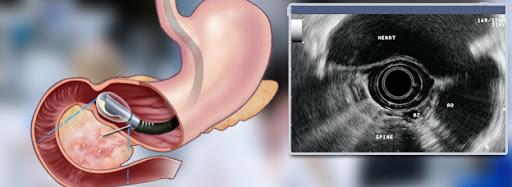
Endoscopic Ultrasound
Endoscopic ultrasound (EUS) is a minimally invasive procedure to assess digestive (gastrointestinal) and lung diseases. A special endoscope uses high-frequency sound waves to produce detailed images of the lining and walls of your digestive tract and chest, nearby organs such as the pancreas and liver, and lymph nodes.
When combined with a procedure called fine-needle aspiration, EUS allows your doctor to sample (biopsy) fluid and tissue from your abdomen or chest for analysis. EUS with fine-needle aspiration can be a minimally invasive alternative to exploratory surgery.
EUS techniques are also used in certain treatments, such as draining pseudocysts. Why it’s done
EUS is used to find the cause of symptoms such as abdominal or chest pain, to determine the extent of diseases in your digestive tract and lungs, and to evaluate findings from imaging tests such as a CT scan or MRI.
EUS may help in prevention of :
- Cancer of the colon, esophagus, lung, pancreas or stomach, and ampullary and rectal cancers
- Lymphoma
- Barrett’s esophagus
- Neuroendocrine tumors
- Pancreatitis and pancreatic cysts
- Bile duct stones
- Sarcoidosis
EUS can help:
- Assess how deeply a tumor penetrates your abdominal wall in esophageal, gastric, rectal, pancreatic and lung cancers
- Determine the extent (stage) of cancer, if present
- Determine if cancer has spread (metastasized) to your lymph nodes or other organs
- Provide precise information about non-small cell lung cancer cells, to guide treatment
- Evaluate abnormal findings from imaging tests, such as cysts of the pancreas
- Guide drainage of pseudocysts and other abnormal collections of fluid in the abdomen
- Permit precise targeting for delivering medication directly into the pancreas, liver and other organs
- EUS is performed on an outpatient basis and is well-tolerated by most people.
You may not be a candidate for EUS if you have had abdominal surgery that changed your anatomy, such as Roux-en-Y gastric bypass.


